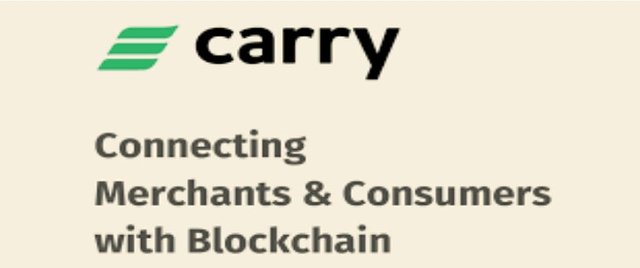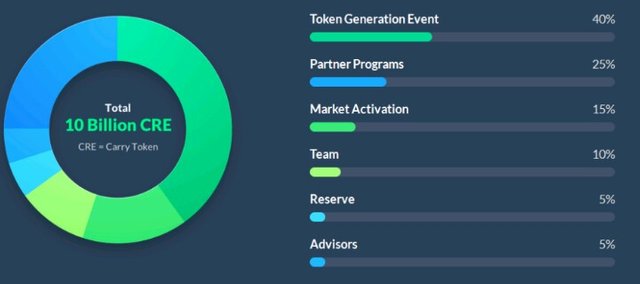Carry Protocol: Bringing Offline Retail into the Blockchain
We’re blessed to have technology at our footstep and at the snap of a finger; we can utilize any technological avenue to solve our problem. You’ll bear witness that there are several online stores and merchant sites where buying and selling holds sway. This is another aspect of technology – online shopping.
Sadly, these online stores and merchant sites likewise have not been able to get the actual target – the offline shoppers. At the moment, the offline commerce market still has a greater output than the online. It might interest you to know that despite the huge success of online and mobile commerce, a greater percentage of shopping still continues offline.
Currently, the offline market has about $25 billion market size and this in my honest view, is a slap in the face of technology. It is a wonder why technology had not fully captured the offline market.
If the future of online and ecommerce must be secured, then a drastic approach should be implemented. It is in the light of this and in abidance to the strategy of providing solutions to problems that Carry Protocol was birthed.
What is Carry Protocol?

Carry Protocol also called Carry is the latest technological innovation to hit the blockchain technology. The core aim of Carry Protocol was to bridge the gap existing between merchants and consumers in the course of a transaction.
Carry Protocol is not essentially a new blockchain marketplace; its aim is to connect offline merchants who are not in tune with ecommerce trading. The target audience of the Carry Protocol project is the offline merchants and real-life consumers. The offline merchant is connected to a real-life consumer or customer through the blockchain ecosystem provided by Carry Protocol.
Why targeting the offline market?
Carry Protocol directed its attention to the offline market because of the huge potential this market offers. The offline market is estimated to have about $25 billion market size which is well over 80% of the total market size.
Its offline market target was also inspired by the fact that most merchants are not in tune with the dictates of technology and thereby, do not have online presence for their businesses and products.
What is wrong with offline marketing?
The offline market is in dire need for improvements as its current setting is not entirely effective. It is distressing that even after technology had provided ecommerce as a means of shopping, most merchants and consumers are yet to key into the platform.

There is also the problem of limited understanding on the part of the merchant. Merchants in offline marketing lack sufficient information about their customers as the customer data at their disposal are fragmented and incomplete.
The second problem is limited or no control over data by the consumers. Consumers in the offline market do not have full control over their data. Companies and businesses instead monopolize and use the data of such consumers in making profit by marketing consumer information at their disposal.
To understand this better, it is pertinent to revisit what happened on Facebook sometime ago. Facebook was once accused of selling the information of its users to some specific individuals in exchange for funds. This is exactly the scenario in the offline market – consumers’ data are sold off without their consent. If the bubble had not burst when it did, it would be impossible for a layman to decipher the secret behind the sale of user information which Facebook was accused of.
We also have the outdated offline advertising module which most offline merchants engage in. These advertising methods are not only outdated but lacks transparency and is unfeasible for sale conversion. It is just like carrying your products or goods about in a wheel barrow soliciting for customers. A technologically-inclined customer will certainly find it hard to make any purchase from you as he has other viable platforms to do so which is online commerce.
It is in the light of this that Carry Protocol was developed to replace and improve the traditional offline marketing. It aims at bringing the offline market into the blockchain technology and not creating an entirely new marketplace.
How can Carry Protocol solve the problem?
Carry Protocol came up with three key objectives that it hopes to utilize in solving the offline market problems:
• Provision of a platform for merchants to understand their customers and communicate with them
• Enable consumers to control their own transaction data and monetize the information
• Offering of a new, effective and transparent advertising channel.
Technology
The core technology behind Carry Protocol is the blockchain technology. Carry Protocol’s blockchain is responsible for transaction database storage and smart contract storage and execution.
The other technology behind Carry Protocol is a set of Application Programming Interfaces (APIs) that is responsible for third-party software connection to the blockchain.

What will I benefit from using Carry Protocol?
Carry Protocol offers many benefits that cannot be overlooked. These benefits are not limited to the merchant only; the consumer and the advertiser are also included in its scope.
For the merchant, the benefits include:
• Quick payment processing
• Issuing returning customers with incentives that come in form of digital coupons and custom branded tokens
• Acceptance of virtual currencies in brick-and-mortar shops
The consumers have these benefits:
• Be in possession of their transaction data
• Monetize their transaction data anonymously
• Collect loyalty coupons and digital coupons as incentives
For the advertiser, Carry Protocol offers these benefits:
• Reach their target audience with little or no advertising fee
• Utilize consolidated offline payment data
Token
Carry Protocol has a token that it utilizes to implement its ecosystem. The token called CRE, is the primary token in the Carry Protocol network. The CRE token can be used by consumer, merchants and advertisers likewise.
Consumers can use the CRE token as currency to pay merchants in the Carry Protocol ecosystem. Consumers can also receive the token from third-part advertisers as payment for their (third-party advertisers) access to their transaction data.
Merchants accept this token as payment for their services.
In summary, the CRE token can be used to:
• Pay at the store
• Share your data
• Receive your rewards
Conclusion
The Carry Protocol project is really an interesting one and really prospective. It offers the merchants a whole new approach to market their goods on their platform. This gives the merchant the opportunity to drift away from the stagnating grip of the offline market to the embracing hold of online commerce; especially one hinged on the blockchain.
The consumer is now at liberty to monetize their transaction data as opposed to its monopolization by businesses in the offline market.
Finally, third-part advertisers can broadcast and bring their services to full view on the Carry Protocol ecosystem with little or no fee.

TEAM

EXTENDED TEAM

ADVISORS

To find out more about Carry Protocol, Kindly check the links below:
Website: https://www.carryprotocol.io
Whitepaper: https://www.carryprotocol.io/static/docs/Carry_protocol-white_paper%28ENG%29.pdf?cachebust=56ce7d511bc65d0aee3d8ba2b2d5c876
Telegram: https://t.me/carryprotocol
Twitter: https://twitter.com/carryprotocol
Writer: Umeh Collins Chidiebere
Email: [email protected]
Great article, I'm gonna make more research on this one. Let's see, I might as well invest